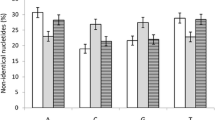Summary
The human hemopexin gene was isolated and its structure determined. The gene spans approximately 12 kb and is interrupted by nine introns. When the intron/exon pattern was examined with respect to the polypeptide segments they encode, a direct correspondence between exons and the 10 repeating units in the protein was observed. The introns are not randomly placed; they fall in the middle of the region of amino acid sequence homology in strikingly similar locations in 6 of the 10 units and in a symmetrical position in the two halves of the coding sequence. These features strongly support the hypothesis that the gene evolved through intron-mediated duplications of a primordial sequence to a five-exon cluster. A more recent gene duplication led to the present-day gene organization.
Similar content being viewed by others
References
Altruda F, Poli V, Restagno G, Argos P, Cortese R, Silengo L (1985) The primary structure of human hemopexin deduced from cDNA sequence: evidence for internal, repeating homology. Nucleic Acids Res 13:3841–3859
Antonorakis ES, Irkin SH, Cheng T, Scott AF, Sexton JP, Trusko SP, Charache S, Kazazian HH Jr (1984) β-thalassemia in American blacks: novel mutations in the “TATA” box and an acceptor splice site. Proc Natl Acad Sci USA 81:1154–1158
Baumann H, Jahreis GP, Gaines KC (1983) Synthesis and regulation of acute phase plasma proteins in primary cultures of mouse hepatocytes. J Cell Biol 97:866–876
Benoist C, O'Hare K, Breathnach R, Chambon P (1980) The ovalbumin gene-sequence of putative control regions. Nucleic Acids Res 8:127–142
Bensi G, Raugei G, Klefenz H, Cortese R (1985) Structure and expression of the human haptoglobin locus. EMBO J 4:119–126
Berk A, Sharp PA (1977) Sizing and mapping of early adenovirus mRNAs by gel electrophoresis of S1 endonuclease-digested hybrids. Cell 17:721–732
Breathnach R, Benoist C, O'Hare K, Gannon F, Chambon P (1978) Ovalbumin gene: evidence for a leader sequence in mRNA and DNA sequences at the exon-intron boundaries. Proc Natl Acad Sci USA 75:4853–4857
Falkner FG, Zachau HG (1984) Correct transcription of an immunoglobulin k gene requires an upstream fragment containing conserved sequence elements. Nature 310:71–74
Frischauf AM, Lehrach H, Poustka AN, Murray N (1983) Lambda replacement vectors carrying polylinker sequences. J Mol Biol 170:827–842
Gilbert W (1978) Why genes in pieces? Nature 271:501
Kozak M (1986) Point mutations define a sequence flanking the AUG initiator codon that modulates translation by eucaryotic ribosomes. Cell 44:283–292
Lerner MR, Boyle JA, Mount SM, Wolen SL, Steitz JA (1980) Are snRNPs involved in splicing? Nature 283:220–224
Messing J, Gronenborn B, Muller-Hill B, Hopshneider PH (1977) Filamentous coliphage M13 as a cloning vehicle: insertion of a Hind III fragment of the lac regulatory region in M13 replicative form in vitro. Proc Natl Acad Sci USA 74:3642–3646
Messing J, Vieira J (1982) A new pair of M13 vectors for selecting either DNA strand of double-digest restriction fragments. Gene 19:269–276
Muller-Eberhard U, Liem HH (1974) In: Allison AC (ed) structure and function of plasma proteins, vol. 1. Plenum, London, p 35
Ohkubo H, Vogeli G, Mudryj M, Avvedimento VE, Sullivan M, Pastan I, de Crombrugge B (1980) Isolation and characterization of overlapping genomic clones covering the chicken 2 (type 1) collagen gene. Proc Natl Acad Sci USA 77:7059–7063
Parslow TG, Blair DL, Murphy WJ, Granner DK (1984) Structure of the 5′ ends of immunoglobulin genes: a novel conserved sequence. Proc Natl Acad Sci USA 81:2650–2654
Sanger F, Nickeln S, Coulson AR (1977) DNA sequencing with chain-terminating inhibitors. Proc Natl Acad Sci USA 74: 5463–5467
Singh H, Sen R, Baltimore D, Sharp P (1986) A nuclear factor that binds to a conserved sequence motif in transcriptional control elements of immunoglobulin genes. Nature 319:154–158
Smith A, Morgan WT (1979) Haem transport to the liver by hemopexin. Biochem J 182:47–54
Stanley KK (1986) Homology with hemopexin suggests a possible scavenging function for S-protein/vitronectin. FEBS Lett 199:249–253
Stein JP, Catterall JF, Kristo P, Means AR, O'Malley BW (1980) Ovomucoid intervening sequences specify functional domains and generate protein polymorphism. Cell 21:681–687
Takahashi N, Takahashi Y, Putnam FW (1985) Complete amino acid sequence of human hemopexin, the heme-binding protein of serum. Proc Natl Acad Sci USA 82:73–77
Tilghman SM (1982) In: 27th Scient Rep Inst Cancer Res 125, Fox Chase Cancer Centre
Vieira J, Messing J (1982) The pUC plasmids, an M13mp7-derived system for insertion mutagenesis and sequencing with synthetic universal primers. Gene 19:259–268
Author information
Authors and Affiliations
Rights and permissions
About this article
Cite this article
Altruda, F., Poli, V., Restagno, G. et al. Structure of the human hemopexin gene and evidence for intron-mediated evolution. J Mol Evol 27, 102–108 (1988). https://doi.org/10.1007/BF02138368
Received:
Accepted:
Issue Date:
DOI: https://doi.org/10.1007/BF02138368




